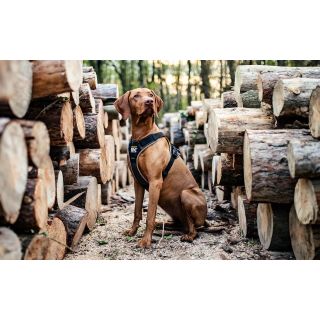There is a lot to consider when planning a hiking route with your dog. Even if you take your four legged companion everywhere with you, going on a long walk and trekking off the beaten path has its own unique challenges that you should plan carefully for.
Although hiking in Britain with a dog may seem tame compared to backpacking aboard, you still need to be prepared and plan carefully to ensure your dog’s wellbeing. Plus you need to be aware of laws and restrictions on certain trails.
In this article we provide an overview of what you should know about hiking with your dog in the UK.
Is your dog suitable for hiking?
The first question you need to ask yourself is if your dog is up to the task. Long walks, lots of time outdoors, and being constantly surrounded by wildlife and new experiences all mean your dog needs to be physically up to the task and have the right temperament.
Breeds
Not all breeds are suited to hiking and walking for hours on end. Brachycephalic dog breeds (breeds with flat-faces and short noses) are not cut out for long walks. These breeds, which include bulldogs, pugs, and boxers, are far more likely to have breathing issues and suffer from over-heating, so will not be able to handle the intensity of a hiking trail.
Hiking is far more suited to medium and larger breeds. They are generally fitter, stronger and have longer legs which make traversing a variety of terrains easier and safer. This isn’t to say smaller breeds can’t hike with you, but they will likely need more assistance overcoming obstacles and cover less ground, slowing down your progress.
Fitness
Your dog needs to be fit enough to handle walking hours on end. From your daily walks, you should already have a good idea of your dog’s stamina and willingness to walk for longer periods. However hiking and backing will take this to the next level.
You should try your dog on longer daily walks to see how they cope, then once you’re confident they can handle longer routes, test them on smaller hiking trails. It’s not a good idea to throw your dog in the deep end of trekking eight to ten miles each day.
If you’re unsure if your dog is suited to hiking you should consult your vet.
Behaviour
Your dog needs to be well behaved around wildlife, livestock, and people. It must be able to obey simple behavioural commands like ‘heel’, ‘stop’ and ‘sit’ to ensure everyone’s safety.
If your dog is prone to run away from you, can’t be trusted off lead, or is inconsistent to obeying orders, than these are essential skills that must be taught to your dog before attempting to go hiking.
Dog friendly hiking routes
Under UK law, a dog is considered a 'usual accompaniment' on a public right of way. You have right of way on hiking trails and walking routes and so you’re legally on these routes with your dog, making them all dog friendly in general.
However, public right of way often goes through privately owned land. Land owned by an individual may have certain restrictions imposed by the landowner which might require you to take certain considerations when hiking with your dog.
On private land your dog is not entitled to stray from the path and if it does you, the dog’s owner, could be guilty of trespassing.
Public right of way and dogs on private land
The Highways Act 1980 states that landowners must allow access to walkers, but this does not extend to dogs.
This means private landowners are in their rights to restrict or completely ban dogs accessing their land. These restrictions can be imposed by both local councils and private landowners. Often these are in place to protect wildlife or foliage in a certain area or could be for your own dog’s safety. But these restrictions on dogs are completely up to the private landowner and there doesn’t have to be any legal reason for them not wanting dogs on their land.
If dog’s are not allowed on certain walking routes or on certain stretches of countryside these need to be clearly signposted by the landowner.
Open access land
Open access land is land that is accessed without the use of a footpath. This land can include moors, mountains and heaths. You are legally allowed to walk dogs on open access land, although there are some restrictions. More information on these restrictions is on the gov.uk website here.
Livestock and farmland
Under UK law, it is an offense if your dog is ‘out of control’ around livestock. Farmers are in their rights to injure or even kill a dog on their land if they feel it is a threat to their livestock.
If you and your dog do find yourself in a field with livestock then you should keep your dog on a lead and under close control.
Hiking and dog fouling
When you’re in the middle of nowhere you might be tempted to just leave your dog’s mess on the ground. This should never be your option and you should always clean up after your dog.
Even out in the wilderness dog mess can be an environmental hazard. Dog fouling can lead to diseases being transmitted to livestock and wildlife, contaminate fresh water, and pose a risk to human health.
Under UK law any person who fails to clear up after their dog can be issued with a Fixed Penalty Notice (FPN) of up to £100. These FPNs can be issued on any land subject to a Dog Control Order, which covers most private land and land controlled by local councils.
Cleaning up your dog’s mess
When out for a long hike it can be difficult to know what to do with your dog’s mess. Here are some suggestions:
- Poop containers: Bring a proper dog poop container (not just a loose plastic bag) and pack it away in your rucksack. This will contain the smell and mess securely.
- Bury it: If the land you are own permits it, bring a small spade with you and bury the mess. If you’re on private land, be sure you’re allowed to dig in the area. The hole should be 6 inches deep and 6 inches wide and you should always bury dog mess at least 500 feet away from natural water sources.
- Dog saddle bags: If you’re not keen on storing your dog’s poop in your rucksack, attach a saddle or side bag to their harness and make them carry their own mess.
Hiking gear for your dog
You should always make sure your walking gear is effective, good quality, and up for the task. This is also true of your dog’s equipment. Before setting out, ensure the dog’s harness, lead, and other accessories can withstand the elements.
A dog harness designed for long walks
The harness you use for your daily walks might be okay for a short stroll around the park, but it might not be suitable to wear for long periods. When walking for hours on end day after day, buying a harness that’s made for hiking will ensure your dog’s comfort and will be able to hand whatever the weather throws at it.
Here at JULIUS-K9® we sell the IDC® Longwalk harness – our own dog harness made especially for long woodland walks, hilly hikes, and mountain trails.
A durable dog lead
Having a durable dog lead that’s reliable, comfortable to hold, and has excellent grip is important when out in the wilderness. Here at JULIUS-K9® we sell a range of Super Grip Dog Leads that do exactly this. They are designed to give you complete control over the lead, even in the pouring rain.
Some walkers like to be hands-free. Using an elastic dog lead and belt prevents your dog from straying off too far but keeps both your hands free.
Dog boots
A pair of good quality dog boots can help protect your dog’s paws and provide an extra level of grip if they have grooved, rubber soles. These are especially useful in rockier regions where loose rocks or sharp pebbles could harm paws. In winter and colder conditions they will also keep your dog warm and protect their paw pads and toes from ice.
Water and bowl
It’s important to stay hydrated when walking but many dog owners forget to bring extra water for their dog, or they don’t think how their dog might actually drink it. A collapsible dog bowl is a great option as it can be easily stored in a rucksack or your dog’s saddle bag.
Saddle bags
Attaching a side bag or saddle bag to your dog’s harness allows them to carry their own gear, food, and even their own mess. Dogs can comfortably carry about 10% of their own body weight in side bags, but always ensure your dog is comfortable carrying any extra weight before setting out.
See our How To Safely Use Dog Saddle Bags article for more information on safely using them.
Poop containers and bags
You should never leave dog mess behind, wherever you are. As mention above, it’s harmful to the environment, other animals and humans, and is illegal. So you should always bring biodegradable poop bags and a specialised poop container to store the mess in until you find a bin.
Tick and flea repellent collar attachments
Many owners like to use ultrasonic insect repellents to stop ticks and fleas from attaching themselves to their dog’s coat. These little devices are attached to your dog’s collar or harness and emit bursts of ultrasonic pulses that warn off pests but are inaudible to humans and pets.
Lights
It is always a good idea to bring a torch with you on a walking trail in case the day gets away from you and you have to do the last leg of your journey in the dark. But you should also add a safety light to your dog’s collar or harness. This will make it far easier to spot them if they get away from you when daylight fades.
Vaccinations and treatments
Make sure your dog is up to date on their vaccinations from the vet. This includes worm and flea medicine and most importantly tick treatments. Tick season starts in September in the UK and ticks can pass on serious diseases to dogs like Lyme disease.
Dog tags and microchipping
It is UK law to have your dog microchipped and wear an ID tag when out in public. Not only is it the law to make sure both of these are up-to-date with your latest information, this is also important in case your dog becomes lost while out on hike far from home.










